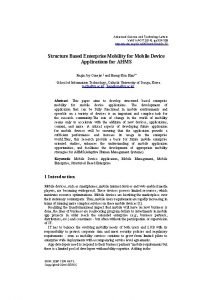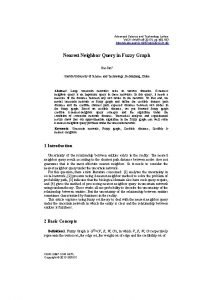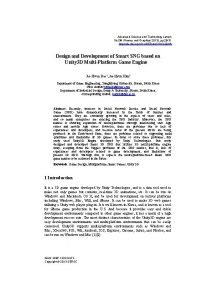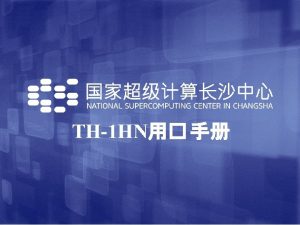Advanced Science and Technology Letters Vol 51 ACIT





- Slides: 5

Advanced Science and Technology Letters Vol. 51 (ACIT 2014), pp. 324 -328 http: //dx. doi. org/10. 14257/astl. 2014. 51. 72 Structure Based Enterprise Mobility for Mobile Device Applications for AHMS Regin Joy Conejar 1 and Haeng-Kon Kim 1* School of Information Technology, Catholic University of Daegu, Korea regin@cu. ac. kr, *hangkon@cu. ac. kr 1 Abstract. This paper aims to develop structured based enterprise mobility for mobile device applications. The development of application that can be fully functional in mobile environments and operable on a variety of devices is an important and complex task for the research community. The rate of change in the world of mobility seems only to accelerate with the addition of new devices, applications, content, and more. A critical aspects of developing future application for mobile devices will be ensuring that the application provide a sufficient performance and increase its usage in the enterprise world. Thus, this research provide a basis for future mobile enterprise oriented studies, enhances the understanding of mobile application opportunities, and facilitates the development of appropriate mobility strategies for AHMS(Adaptive Human Management Systems). Keywords: Mobile Device Application, Mobile Management, Mobile Enterprise, Structured Based Enterprise 1 Introduction Mobile devices, such as smartphones, mobile internet devices and web-enabled media players, are becoming widespread. These devices possess limited resources, which motivates resource optimizations. Mobile devices are hawking the marketplace over their stationary counterparts. Thus, mobile users requirement are rapidly increasing in terms of running more complex services on these mobile devices [1]. Realizing the transformational impact that mobile will have on how business is done, the lines of business are reallocating program dollars to investments in mobile app projects in order reach the extended enterprise (e. g. , business partners, distributors, etc. ) and consumers - but often without the participation or supervision of IT. IT has to balance the evolving mobility needs of both users and LOB with its responsibility to protect corporate data and meet security policies and regulatory requirements - even as mobility services continue to grow from limited pilots to enterprise wide deployments with accompanying service level agreements. App developers need to respond to their business partners’ mobile requirements but there is a limited pool of developers with mobility expertise. Adding in the ISSN: 2287 -1233 ASTL Copyright © 2014 SERSC

Advanced Science and Technology Letters Vol. 51 (ACIT 2014) requirement that apps must offer security controls that meet the need of enterprise IT further limits this pool. Businesses are in the unenviable situation of having to compromise where it matters most - business innovation, user satisfaction and productivity–in the name of security and manageability. With the fast development of mobile enterprise, wireless mobile networks and mobile devices are becoming widely used in both commercial and academic organizations. Mobile enterprise integrates computation into the environment, rather than having computers which are distinct objects. In these researches, collaboration is a very important application of information technology, especially for mobile enterprises. This research aims to develop structured based enterprise mobility for specifically to the development of mobile device applications. Structured based enterprise mobility platform would greatly help in easing the development process of mobile device application development for mobile platforms since it would address the problem of redundancy of tasks in developing a application that would run on several platforms. By having a high-level model that would describe the application and having this model is transformed to mobile device application for different mobile platforms. 2 Background of the Study Mobile devices are becoming the most indispensable computing and communicating device a person needs. With the advent of smart phones, the mobile phone has become as powerful as any ordinary desktop computer in terms of the services it can offer and its communication power [2]. People are now using their mobile phones not just for calling and sending messages but also for browsing the Internet, playing games, listening to music, taking pictures and videos just to name a few of the mobile device services. In response to the rising demand for better mobile device services, companies have developed various types of mobile device services that would suit different people with different mobile needs. 2. 1. Mobile Enterprise Challenges Mobile access to enterprise applications is fast becoming a standard part of corporate life. Such applications increase organizational efficiency because mobile devices are more readily at hand than their desktop counterparts. However, the speeds with which mobile platforms are evolving create challenges as enterprise defines their mobile strategies. Smart phones such as i. Phone are powerful platforms, but different mobile platforms offers different tools and language for developers [3]. To simplify development and maintenance many enterprises pursue a browserbased mobile application strategy. Online applications that end users access from browsers on mobile devices offer less device service integration in exchange for easier application development, management, and portability. But as browsers evolve and new mobile platforms emerge, ensuring that online Web applications render well Copyright © 2014 SERSC 325

Advanced Science and Technology Letters Vol. 51 (ACIT 2014) to the proliferation of new smart devices creates further challenges to corporate IT trends. In this research building mobility strategy helps enable a mobile enterprise to achieve high performance. As part of these decisions, enterprises are assessing the role of service providers in supporting the development, implementation, and management of this strategy. 3 Structured based Enterprise Mobile Concept Structured basedenterprise mobility includes mobile app security, mobile app management and infrastructure and device management technologies to allow your organization to implement all three steps. Mobile devices services developers can easily build enterprise-ready, secured mobile apps for the most popular native (i. e. , Apple i. OS, Google Android) and hybrid development environments. Fig. 1. Enterprise Mobility Structured Figure 2 as a structured based concept, mobile enterprise process helps define, articulate, and prioritize key business objectives and success criteria as well as user needs and benefits prior to the development of mobile road maps and application concepts. This process serves to support alignment across functions — business leads, marketing, and IT — with the goal of driving realvalue for both the enterprise and the user by identifying key innovations and differentiators that are in line with stated objectives. 326 Copyright © 2014 SERSC

Advanced Science and Technology Letters Vol. 51 (ACIT 2014) 4 Mobile Device Applications Mobile devices bids convenient and appropriate traditions to map human relations in a global atmosphere and are frequently an essential part of product instances. By means of a mobile device it is simpler that moving to reach a touch screen nearby. Furthermore, one does not have to stay in line to use a mobile device, as it would be the case with sharing a common device when there are other people in the same place. Using mobile devices for interaction, also does not conflict with using other forms of communication, e. g. , voice and gestures, but can be used to enhance them. Mobile phones were the first mobile devices to have global success and wide acceptance. Based on this success, there is a trend to enrich the number of services that are offered to people via mobile phones, benefiting from an extensive existing user base. Fig. 2. Overview of Mobile Device Application Mobile device application usage undertakes and enterprise application delivery requires always on connectivity. To take full advantage of the mobile devices, they must be able to connect reliably and deliver a comparable experience to the wired network. This fact will only increase as mission critical enterprise computing becomes more available on mobile platforms. Enterprises need to support multiple devices on one end, and build mobile applications that can access enterprise services on the other end. Enterprise mobility platform provides the capability set to enable this transformation effectively. Some of the key components that enterprises need for a comprehensive mobility solution include an application development platform, enterprise applications management and enterprise mobility gateway, enterprise service orchestration, device management, device testing, and mobility application hosting and management. Mobility represents an opportunity to build better internal business processes and stronger customer and partner relationships. Copyright © 2014 SERSC 327

Advanced Science and Technology Letters Vol. 51 (ACIT 2014) 5 Conclusion The rapid development of mobile device and its application brings an immeasurable impact in the enterprise technology world. The objective of this research is to understand the benefits and challenges of mobile enterprise, facilitate the development of appropriate mobility strategies, and provide a basis for future mobile enterprise oriented studies. To provides mobile device applications that allow enterprise developers to control advantage’s support to expose and manage custom app-specific policies. The structured based enterprise mobility provide a basis for future mobile enterprise oriented studies, enhances the understanding for mobile application opportunities. Acknowledgement. This research was Supported by the MSIP (Ministry of Science, ICT and Future Planning), Korea, under the CITRC (Convergence Information Tech-nology Research Center) support program (NIPA-2014 -H 0401 -14 -1008) supervised by the NIPA (National IT Industry Promotion Agency). This research was also supported by the International Research & Development Program of the National Research Foundation of Korea (NRF) funded by the Ministry of Science, ICT & Future Planning (Grant number: K 2012057499). References 1. G. M. Kapitsaki, D. A. Kateros, G. N. Prezerakos, and I. S. Venieris, “Model-driven development of composite context-aware web applications, ” Information and Software Technology, vol. 51, no. 8, pp. 1244– 1260, 2009. 2. G. D. Abowd, L. Iftode, and H. Mitchell. Guest editors’ introduction: The smart phone– a first platform for pervasive computing. IEEE Pervasive Computing, 4(2): 18– 19, 2005. 3. Develop Mobile Applications. With Oracle Adf Mobile, http: //www. oracle. com/technetwork/developer-tools/jdev/adf-mobile-development 129800. pdf 4. Basole, R. C. & De. Millo, R. A. (Forthcoming). Enterprise IT and Transformation. In W. B. Rouse (Ed. ), Enterprise. 5. Rouse, W. B. (2005). Enterprises As Systems: Essential Challenges & Approaches to Transformation. Systems Engineering, 8(2). 6. M. Gaedke, M. Beigl, H. -W. Gellersen, and C. Segor, “Web content delivery to heterogeneous mobile platforms”, In ER ’ 98: Proceedings of the Workshops on Data Warehousing and Data Mining, pages 205– 217, London, UK, 1999. Springer-Verlag 7. G. D. Abowd, L. Iftode, and H. Mitchell. Guest editors’ introduction: The smart phone– a first platform for pervasive computing. IEEE Pervasive Computing, 4(2): 18– 19, 2005. 328 Copyright © 2014 SERSC








